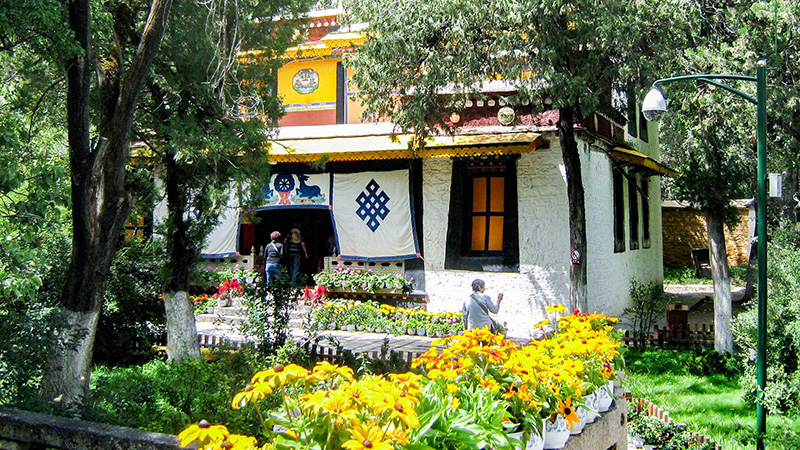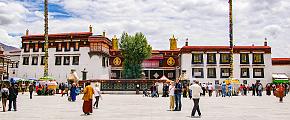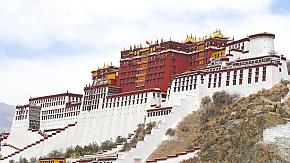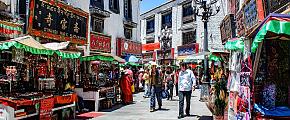Tibetan Food and Cuisine
Tibet, known as the "Roof of the World," is famous for its unmatched beauty and ancient history. The Tibetan Food has had to adapt to the extremely high altitudes and harsh climate. Due to the extremely high altitudes, and harsh climate, Tibetan culture has had to adapt. Tibetan food has also adapted. Tibetan food is not only sustenance but also helps Tibetan people survive harsh climates. Their food keeps them warm, gives them energy, helps them with the high altitude, and gives them nutrients essential to the harsh climate. Due to the high altitude of Tibet, water boils at 90 degrees making cooking with water impossible, and vegetables are scarce in the high altitude, so Tibetan cuisine has become very specialized. The main ingredients are meat and dairy products. The food in Tibet shows a strong similarity to that in India and parts of China but is uniquely Tibetan.
 Norbulingka Park, Lhasa
Norbulingka Park, Lhasa
Tsampa: Tsampa is the staple food of the Tibetan people. Tsampa is a dough made with roasted barley flour and yak butter. There are several ways to prepare for Tsampa. The Tsampa served with buttered tea is salty, while the Tsampa made into porridge is usually sweet. Tibetan people eat Tsampa at every meal, and when traveling, it is brought along as a ready-made meal. To create Tsampa, Tibetans put some ghee (yak butter) in a bowl, pour some boiled water or tea into the bowl, add some roasted barley flour into the water or tea, mix, and then knead the mixture into dough balls and eat them.
Meat: People living at higher altitudes generally consume more meat than those of the lower regions, where a variety of vegetables are available. The most commonly eaten meat in Tibet is beef and mutton. Beef and mutton contain a lot of protein which is helpful in fighting the cold. Many Tibetans often eat raw meat. Dried beef and mutton strips are also popular foods in Tibet. The dried meat is crisp and tasty and can be eaten raw since the cold temperature in the winter has killed bacteria during the process of drying making it very safe to eat. The dried meats can be stored and are useful when traveling long distances. Tibetans are also very fond of sausages. Blood sausage, meat sausage, flour sausage, and liver sausage are very popular among Tibetans.
Beverages: In Tibet, there are several kinds of beverages that are staples at every meal. Buttered tea, sweet tea, and change are the most common. Butter tea gives the drinker energy and so is especially suited to high altitudes. Beloved by nearly all Tibetans, butter tea is drunk while eating Tsampa. The buttered tea is quite salty, some people think it tastes more like soup broth than tea. Tibetan sweet tea is similar to English and Indian teas. The tea, along with milk and sugar, are boiled together giving the tea a distinct flavor. Chang, a thick, white barley beer, is sweet and low in alcohol content.
In the past, in the countryside of Tibet, few people ate chicken and some even freed roosters, thinking it was unworthy to "kill life for a handful of meat." At present, chickens, eggs, pork, beef, and mutton have all become common foods. In many Tibetan cities or towns, where there is an abundance of food, Tibetan food is supplemented by Chinese food, mostly Sichuan food. Vegetables and fish have become available in the markets. Along with changes in diet, some habits, including eating raw meat, have been replaced by scientific, nutritious and hygienic diet therapies.
Contact us if you want to explore more of Tibet or other cities of China.
Quick Question
What Our Clients Say
"Great Customized Service", "Trip of A Lifetime", "Exceed All Expectations"
SUBSCRIBE TO WIN A FREE TOUR
Subscribe to our newsletter for a chance to win a free 7-day India tour! And more insider travel news, exclusive offers, and inspiration will be sent straight to your inbox.






